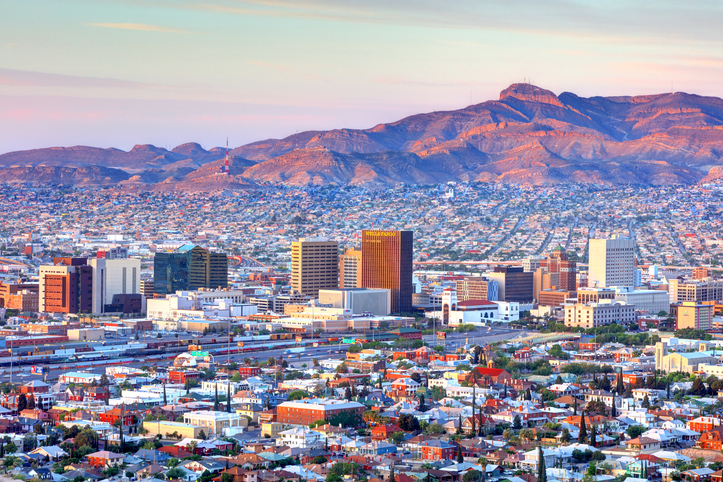
4 Facts to Strengthen Resilience for Texas’ Small Businesses
Introduction
Texas small businesses are a vital part of the state’s economy. The Lone Star State is home to over 3.2 million small businesses, making up around 99% of all Texas businesses.1 Over 44% of Texas workers are employed by small businesses.2 While small businesses are vital in Texas, many face unique challenges in an ever-changing economy and must now confront the impacts of climate change. Understanding the current state of small businesses’ emergency preparedness in Texas offers a foundation for addressing the barriers and unique challenges they face in navigating climate change. These insights are crucial for policymakers aiming to develop targeted interventions that ensure small businesses can keep their doors open and continue contributing to the state’s economy.
Across the nation, small businesses encounter significant obstacles in preparing for and responding to climate change as they often face more financial constraints than larger firms.3 Every year, Texas faces the consequences of climate-related events ranging from hurricanes and coastal storms, droughts, wildfires, tornadoes, rising temperatures, and extreme heat;4,5 all of which have direct economic losses for small businesses.6 In the past five years, Texas has endured 55 separate ‘billion-dollar climate disaster events’ that have cost7 the state between $50-100 billion.8 With the increasing frequency and severity of extreme weather events, small businesses across the state face substantial risks if not prepared adequately.
In 2022, the Federal Reserve’s Small Business Credit Survey found that about 1 in 7 Texas small businesses reported experiencing losses from natural disasters in the prior year.9 Considering that small businesses make up the majority of Texas’ businesses, the consequences of climate change pose an increasing risk to the local communities that rely on these businesses for revenue, employment, community contributions, and the state’s overall economy. Despite these risks, few businesses have measures in place, such as hazard insurance, to reduce their risk in the face of natural disasters.
In this data factsheet, we use data from our 2022 survey of small businesses to examine the relationship between emergency preparedness, climate change risk perception, formal sustainability planning, and business location type. Emergency preparedness refers to the steps small businesses take to ensure their business is safe before, during, and after an emergency or natural disaster. The survey measured three dimensions of emergency preparedness by asking businesses if they had natural disaster insurance (flood, earthquake, or fire insurance), purchased a generator, and implemented measures against flood and wind damage.
Data
Our findings stem from a convenience sample survey of over 600 small business owners and managers across Texas, offering valuable insights, though not fully representative. The telephone survey was conducted by UCLA LPPI and the UCLA Center for Neighborhood Knowledge between November 2022 and September 2023. The survey featured 52 questions on topics such as access to capital, technology, cybersecurity, recovery from COVID-19, environmental sustainability practices, climate change impacts, and energy costs.
The key findings focus on seven key questions: Is this a home-based business? Do you have flood, earthquake, or fire insurance? Have you taken steps to flood- or windproof your facility? Do you have a backup generator? Is this business a member of a business association? Have you implemented any sustainability measures? Does your business have a formal sustainability plan? Findings are reported only for statistically significant results (p < 0.05), with sample sizes varying across key findings as not all respondents answered every question.
Key Findings
1. Home-based businesses were less likely to have natural disaster coverage than those with a storefront.
Insurance boosts resilience for small businesses by offering financial protection during severe economic hardship caused by natural disasters. It also helps them recover faster by providing financial support after a disaster. However, access to insurance can vary widely, and our findings show that one-third (33%) of all surveyed small businesses reported they lacked disaster insurance.
The percentage of businesses without insurance increases when comparing disaster coverage rates between storefront and home-based businesses. About 47% of home-based businesses did not have insurance compared to 28% of businesses with a storefront.
While limited research exists on home-based businesses at the national and state-specific levels, our findings highlight a gap in natural disaster insurance for home-based small businesses and a potential gap in resilience. This finding suggests that business location type may impact the ability of small businesses to recover quickly from a flood, earthquake, or fire.
Figure 1: Flood, earthquake, or fire insurance coverage by business location type
Note: Valid sample size = 584; excluded respondents that answered “not sure" or "don’t know”.
Source: UCLA LPPI analysis of original survey data collected by WestGroup Research between November 2022 to September 2023.
2. Small businesses with memberships to business associations were more likely to have natural disaster coverage than those without.
Business associations may provide important resources that support small business stability and growth, such as access to mentorship, industry insights, funding, and skill-building opportunities.10 Associations also foster community, enabling entrepreneurs to connect, share challenges, and learn best practices.11 Membership can enhance disaster preparedness through training programs and workshops to prepare for and respond to natural disasters.12
Our findings show that businesses that reported belonging to a business association, such as a chamber of commerce, state or local groups, ethnic business associations, or industry organizations, were more likely to have disaster insurance – 71% of those with a membership compared to 61% of non-members. These results underscore how business associations can play a crucial role in bolstering small businesses’ disaster readiness and capacity to navigate the risks.
Figure 2: Flood, earthquake, or fire insurance coverage by business association membership status
Note: Valid sample size = 577; excluded respondents that answered “not sure" or "don’t know”.
Source: UCLA LPPI analysis of original survey data collected by WestGroup Research between November 2022 to September 2023.
3. Small businesses with sustainability plans were more prepared for emergencies from natural disasters than those without.
Integrating sustainability efforts with emergency preparedness is increasingly recognized as essential for small businesses,13 especially as climate change amplifies the severity of natural disasters. Studies indicate that businesses with formal sustainability or resilience plans tend to be better prepared for natural disasters.14 As climate change increases the frequency and severity of such events, sustainability planning can help small businesses build resilience.
Our data shows that businesses with formal sustainability plans or who were in the process of developing them were more likely to have purchased a generator and to have implemented wind and flood protection measures. For instance, small businesses with a formal sustainability plan were more likely to have purchased a generator than those with no intentions of developing one (55% versus 28%, respectively). Small businesses with a formal sustainability plan were almost twice as likely to have implemented wind or flood protection measures than those with no intentions of developing one (41% versus 22%, respectively). The results highlight the potential of sustainability planning to enhance the resilience and stability of small businesses during extreme weather and natural disasters.
Figure 3a. Obtained a generator by formal environmental sustainability planning
Note: Valid sample size = 592; excluded respondents that answered “not sure" or "don’t know”.
Source: UCLA LPPI analysis of original survey data collected by WestGroup Research between November 2022 to September 2023.
Figure 3b. Taken action to flood-proof or wind-proof facility by formal environmental sustainability planning
Note: Valid sample size = 570; excluded respondents that answered “not sure" or "don’t know”.
Source: UCLA LPPI analysis of original survey data collected by WestGroup Research between November 2022 to September 2023.
4. Small businesses that adopted sustainability measures were more likely to invest in emergency preparedness than those that did not.
Among the small businesses surveyed, those that had implemented sustainability measures were more likely to have purchased natural disaster insurance and implemented flood and wind protection measures than those that had not. Sustainability measures include increased use of energy-efficient technology and equipment, installation of solar panels, purchasing or replacing vehicles toward a zero-emission fleet, reducing waste and water consumption, increasing recycling, and developing sustainable products and services, among other measures. Surveyed businesses with sustainability practices in place were more likely to have natural disaster insurance (79%) than those without (61%); and more likely to have implemented flood and wind protection measures (35%) than those without (24%). These findings suggest that businesses focusing on sustainability are investing in preventative measures to protect themselves from disasters such as power outages and adopting broader practices to enhance their overall resilience and environmental responsibility.
Figure 4a. Had natural disaster insurance for business by sustainability measure adoption
Note: Valid sample size = 573; excluded respondents that answered “not sure" or "don’t know”.
Source: UCLA LPPI analysis of original survey data collected by WestGroup Research between November 2022 to September 2023.
Figure 4b. Flood and wind protection insurance for business by sustainability measure adoption
Note: Valid sample size = 566; excluded respondents that answered “not sure" or "don’t know”.
Source: UCLA LPPI analysis of original survey data collected by WestGroup Research between November 2022 to September 2023.
Conclusion
This brief underscores significant gaps in emergency preparedness for Texas small businesses. Our findings show Texas home-based businesses may be more vulnerable than store-front businesses due to insurance coverage gaps. Additionally, business association members are more likely to have disaster insurance, and businesses with sustainability plans are more proactive in implementing protective measures. The findings underscore the need for increased awareness and action to bolster climate change knowledge and sustainability planning to strengthen small business stability and resiliency during emergencies, such as natural disasters and extreme weather events.
End Notes
1 U.S. Small Business Administration Office of Advocacy, 2023 Small Business Profiles: Texas (Washington, D.C.: U.S. Small Business Administration, 2023), available online.
2 Ibid.
3 Lawhorn Julie M., and Lindsay R. Bruce, Federal Disaster Assistance for Businesses: Summaries and Policy Options (Washington, D.C.: Congressional Research Service, 2023), available online.
4 Public Citizen, Climate Change in Texas (Public Citizen, 2024), available online.
5 U.S. Environmental Protection Agency, Climate Change: Texas (Washington, D.C.: U.S. Environmental Protection Agency, 2016), available online.
6 Funderburk Brianna, and Misera Lucas, The Impact of Natural Disasters on Small Businesses (Fed Small Business, November 2022), available online.
7 NOAA determines costs of billion-dollar climate disaster events using public and private sector sources. Costs include: physical damage to residential, commercial, and municipal buildings; material assets (content) within buildings; time element losses such as business interruption or loss of living quarters; damage to vehicles and boats; public assets including roads, bridges, levees; electrical infrastructure and offshore energy platforms; agricultural assets including crops, livestock, and commercial timber; and wildfire suppression costs, among others.
8 National Centers for Environmental Information, State Climate Summary: Texas (National Oceanic and Atmospheric Administration, 2024), available online.
9 Fed Small Business, 2023 Firms in Focus: Findings from the 2022 Small Business Credit Survey, Chartbook on Texas Employer Firms (2023), available online
10 National Business Association, “Joining a Small Business Association,” National Business Association, 2024, available online
11 Johnson, Jamie, “Local Business Organizations for Small Business Owners,” U.S. Chamber of Commerce (blog), 2021, available online
12 U.S. Chamber of Commerce Foundation, “Chambers of Commerce Preparedness,” U.S. Chamber of Commerce Foundation, 2024, available online
13 U.S. Small Business Administration, “SBA Urges Small Businesses to Strengthen Resilience During National Disaster Preparedness Month,” U.S. Small Business Administration, September 20, 2024, available online
14 Restore Your Economy, “Engaging the Business Community in Disaster Preparedness,” Restore Your Economy, 2024, available online.
ACKNOWLEDGMENTS
This data brief series was made possible with the generous support of JP Morgan Chase Global Philanthropy and the James Irvine Foundation. The California Latino Legislative Caucus provides core operating support for the UCLA Latino Policy and Politics Institute. The authors are also grateful for Silvia R. González, Paul M. Ong, Misael Galdámez, Chhandara Pech, and Yina Marin for their valuable feedback and review.
The Latino Policy and Politics Institute at UCLA acknowledges the Gabrielino/Tongva peoples as the traditional land caretakers of Tovaangar (the Los Angeles basin and So. Channel Islands). As a land grant institution, we pay our respects to the Honuukvetam (Ancestors), ‘Ahiihirom (Elders), and ‘Eyoohiinkem (our relatives/relations) past, present, and emerging.











